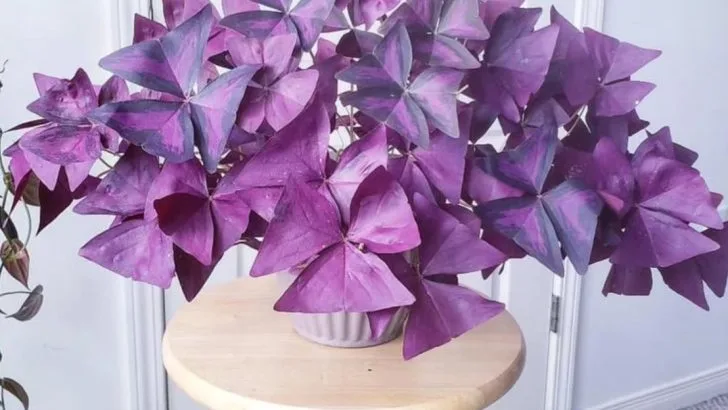Think all houseplants stay the same shade of green? Think again. Some indoor plants are full of surprises—and their biggest trick? Changing color based on how much light they get.
From deep purples that emerge in bright sun to variegated leaves that fade or intensify in shade, these color-shifting beauties are like mood rings for your windowsill. One plant might turn pink in a south-facing window, while another reveals golden stripes when moved just a few feet closer to the light.
Whether you’re a beginner looking for something eye-catching or a seasoned plant parent ready to experiment with indoor lighting, these 17 chameleon-like houseplants bring a whole new level of interest to your space. Just adjust the light—and watch the magic happen.
Calathea Medallion

Calathea Medallion is like a living canvas, painted with intricate patterns. The leaves boast a rich, deep green that shifts to a stunning purple underside. This plant thrives under indirect light, which enhances its colorful display. As the light changes through the day, watch as it folds and unfolds its leaves, like a daily dance orchestrated by the sun. Perfect for those who appreciate a bit of drama in their décor, it’s a conversation starter. Did you know that the term ‘Calathea’ means ‘basket’ in Greek, hinting at how its leaves fold up at night?
Croton
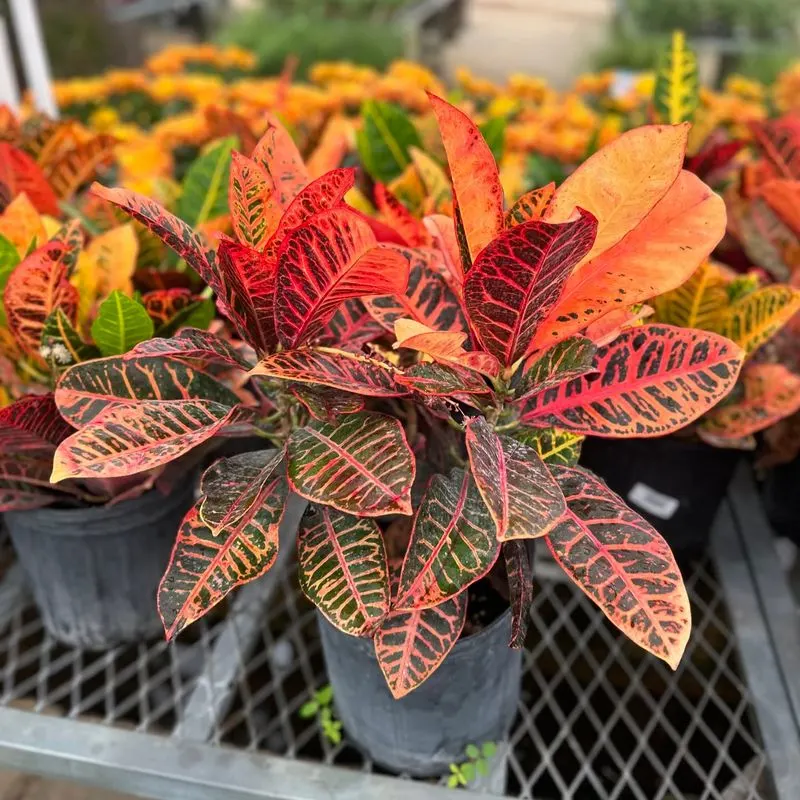
Known for its flamboyant colors, the Croton’s leaves are a kaleidoscope of red, orange, and yellow. These colors deepen with increased sunlight, making it a favorite for those who love bright, eye-catching foliage. As if painted by an artist who can’t decide on just one color, the Croton adapts its hues throughout the seasons. Place it where it can soak up the sun’s rays, and it will reward you with its most vibrant display. A fun fact: in native Malaysian cultures, Crotons are thought to ward off spirits.
Purple Heart
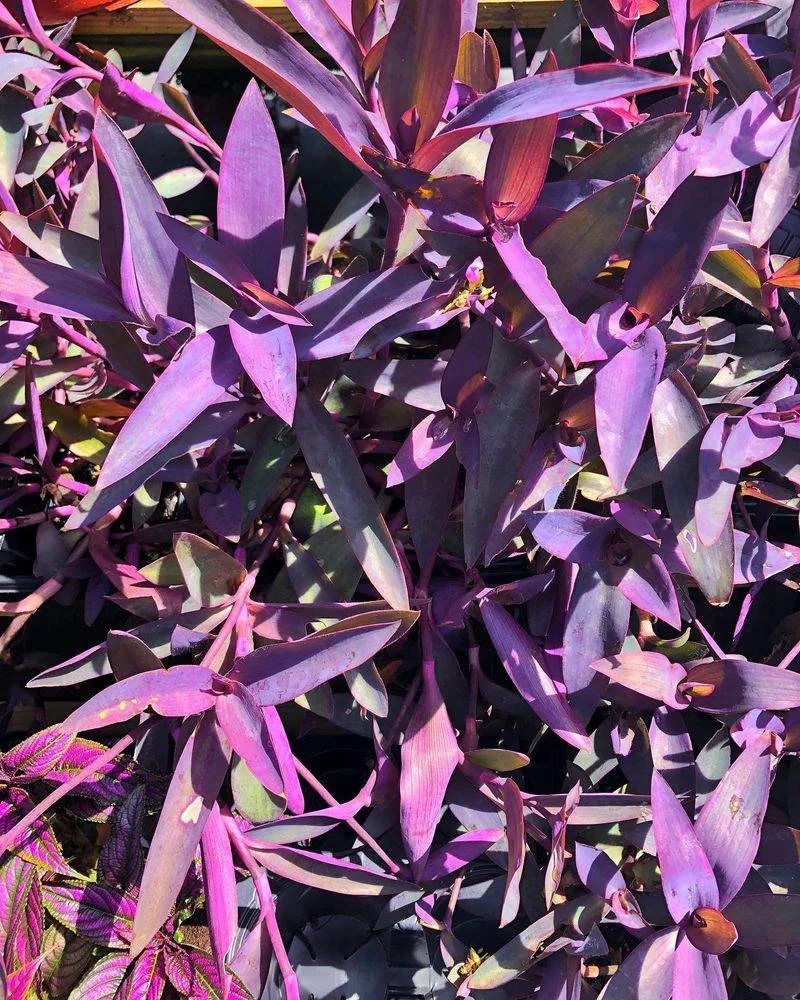
Purple Heart isn’t just a name, but a testament to its deep, royal purple leaves. This resilient plant thrives in both sun and shade, shifting from a darker shade to a more vibrant purple with light exposure. It’s like having a piece of the twilight sky in your home, subtly changing with the sun’s position. Easy to care for and beautifully striking, it’s perfect for those who prefer a touch of elegance without fuss. An added bonus: it’s known for its air-purifying capabilities, quietly working to improve your home’s air quality.
Oxalis Triangularis
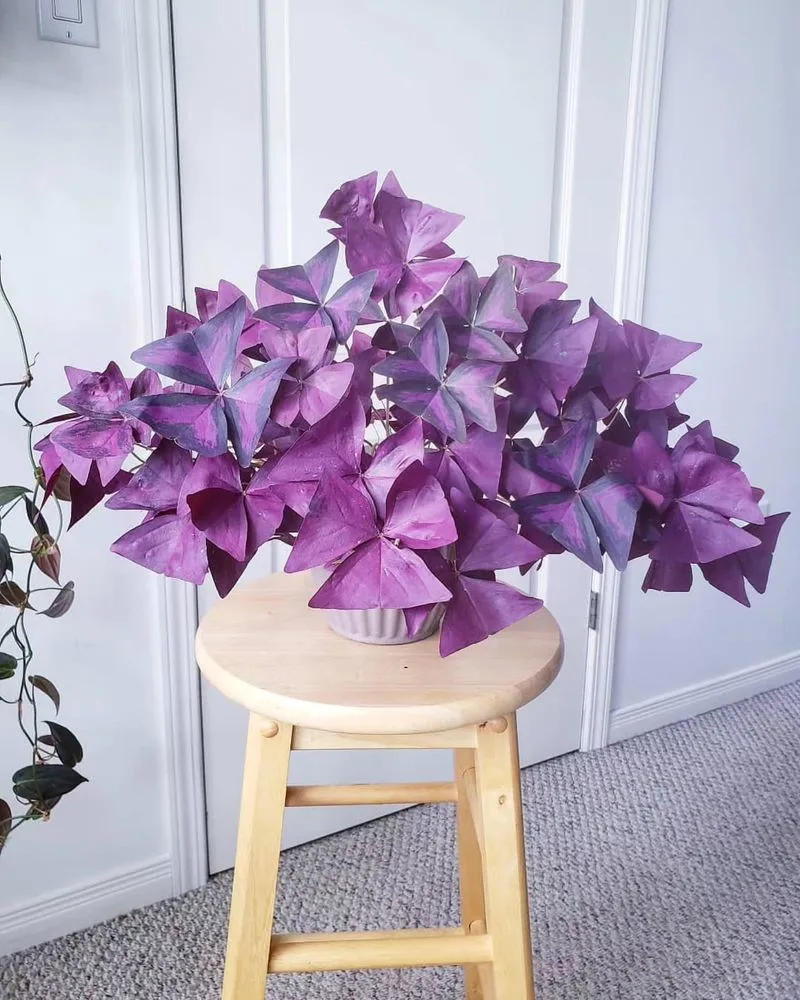
Often called the ‘False Shamrock,’ Oxalis Triangularis captivates with a mesmerizing leaf movement akin to butterflies resting on a stem. Its triangular, purple leaves open in the morning light and close as if asleep at night. With adequate light, the purple deepens, creating a rich visual contrast against its delicate white flowers. This plant is more than just its striking appearance; it’s also edible, having a tangy flavor that complements salads. Originating from Brazil, it embodies tropical vibrancy in a compact form, perfect for adding a whimsical touch to your space.
Maranta Leuconeura
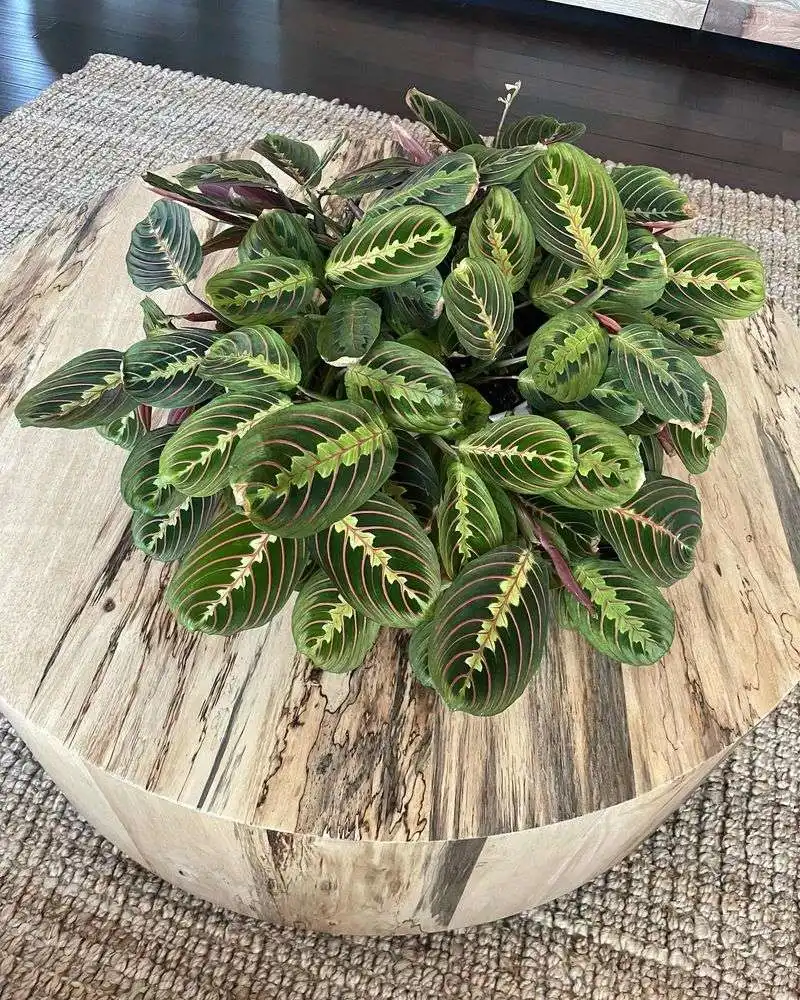
Also known as the ‘Prayer Plant,’ Maranta Leuconeura’s leaves move in a fascinating dance, bowing upwards as night falls, as if in prayer. Its leaves exhibit a tapestry of green with red veins, becoming more vivid with indirect light. This plant appreciates a consistent environment to showcase its best colors, avoiding direct sunlight. Each leaf is a masterpiece, painted by nature. A glimpse into its origin reveals that it hails from the Brazilian rainforests, where humidity and light play their roles in its theatrical leaf movement.
Polka Dot Plant
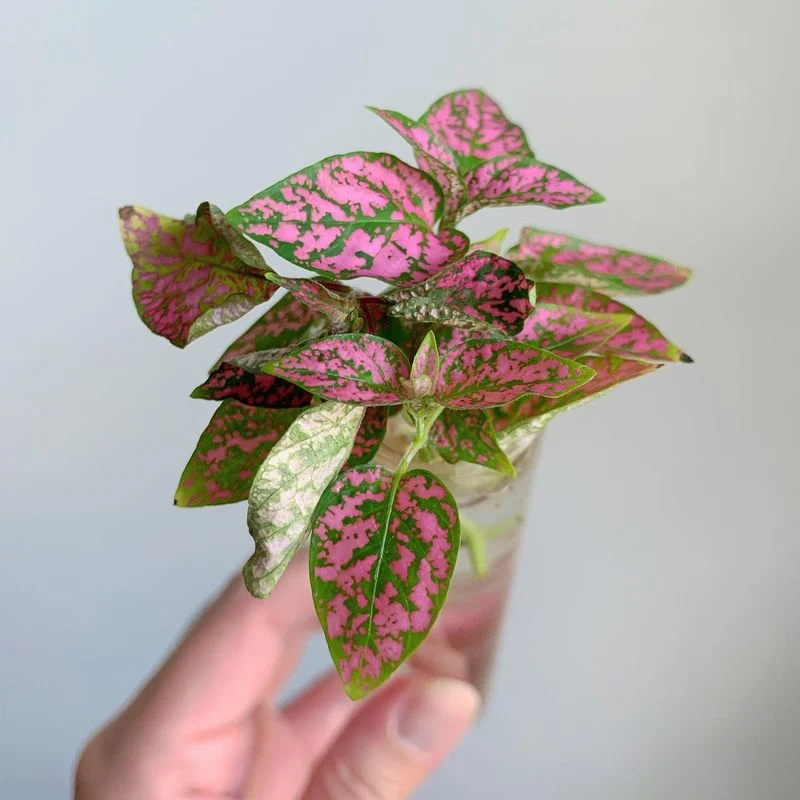
With its cheerful pink or red speckles, the Polka Dot Plant is like confetti captured in leaf form. Its colors intensify under bright, indirect light, transforming it into an exciting spectacle. This plant flourishes when given a bit of attention, rewarding caregivers with even more vibrant hues. Ideal for adding a pop of color to any room, it’s a favorite among playful decorators. Beyond its aesthetics, the Polka Dot Plant is also a symbol of prosperity in some cultures, believed to bring good luck to its owners.
Coleus
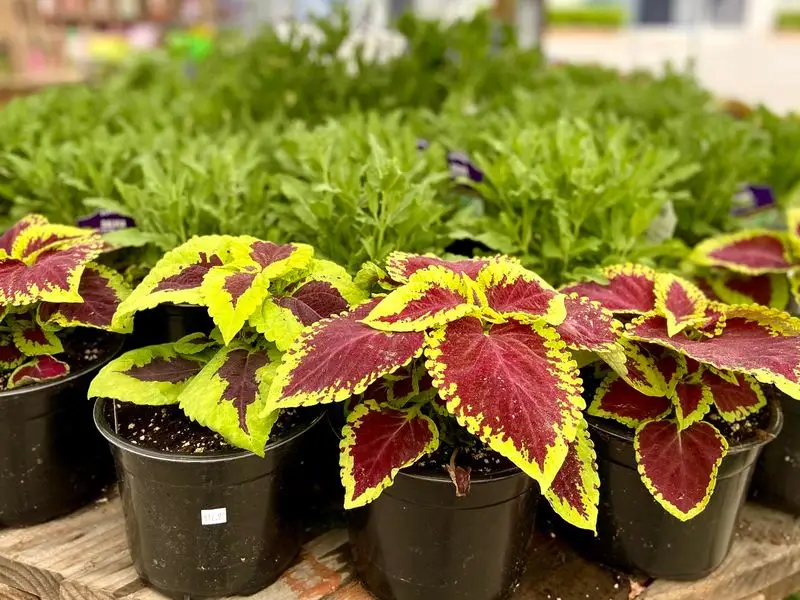
Coleus is the artist’s palette of the plant world, showcasing a breathtaking array of colors depending on the light it receives. Reds, purples, and greens blend seamlessly on its leaves, creating a tapestry that changes with the sun’s rays. In bright light, these colors become even more pronounced, making it a favorite for garden enthusiasts. Besides its visual appeal, Coleus is easy to propagate, allowing you to share its beauty with friends. Did you know? In Victorian times, Coleus was often grown indoors to add vibrancy to parlors.
Fittonia
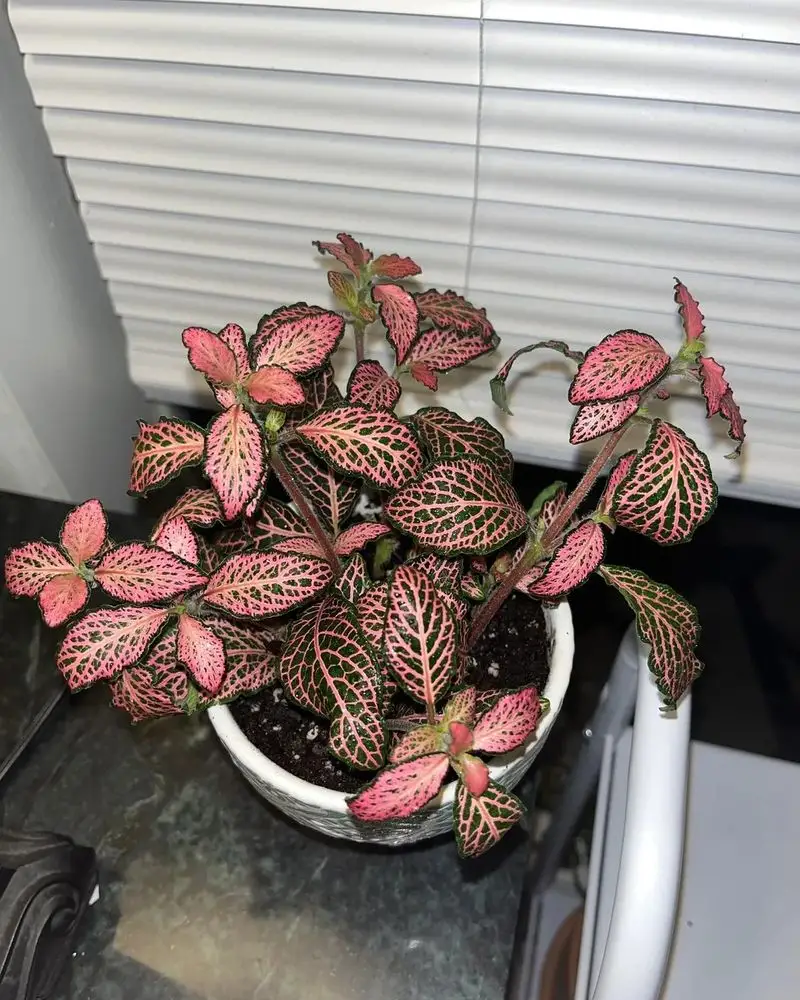
Fittonia, affectionately known as the ‘Nerve Plant,’ features striking leaves with contrasting veins of white or pink. Its appearance is reminiscent of a delicate tapestry, making it a charming addition to any plant collection. The colors on its leaves intensify in indirect light, providing a subtle yet intriguing spectacle. Ideal for those who appreciate fine details, Fittonia requires humidity to thrive, often making it a staple in terrariums. A quirky tidbit: in its native Peru, it grows in the rainforest understory, thriving in the dim light beneath the canopy.
Chinese Evergreen
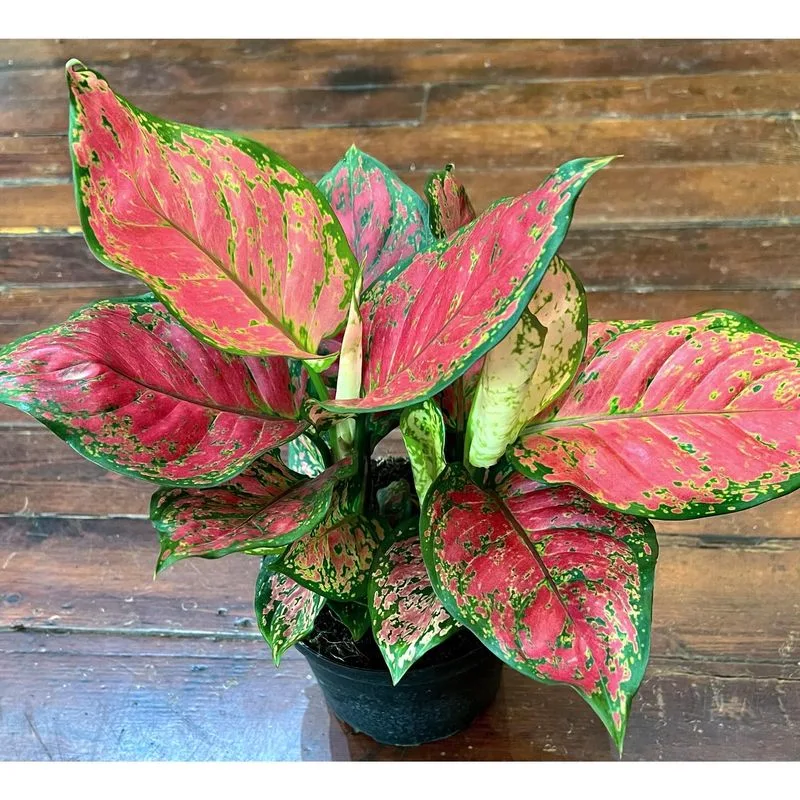
Chinese Evergreen brings an understated elegance with its variegated green and silver leaves. Thriving in low light conditions, it’s perfect for adding a touch of nature to dim corners. This plant is not only about beauty; it’s also known for its air-purifying qualities, quietly working to improve indoor air quality. As it adapts to different light levels, its leaves may change hues slightly, rewarding patient caregivers with subtle shifts in color. A fun fact: it’s considered a lucky plant in Asian cultures, often associated with longevity and prosperity.
Peperomia
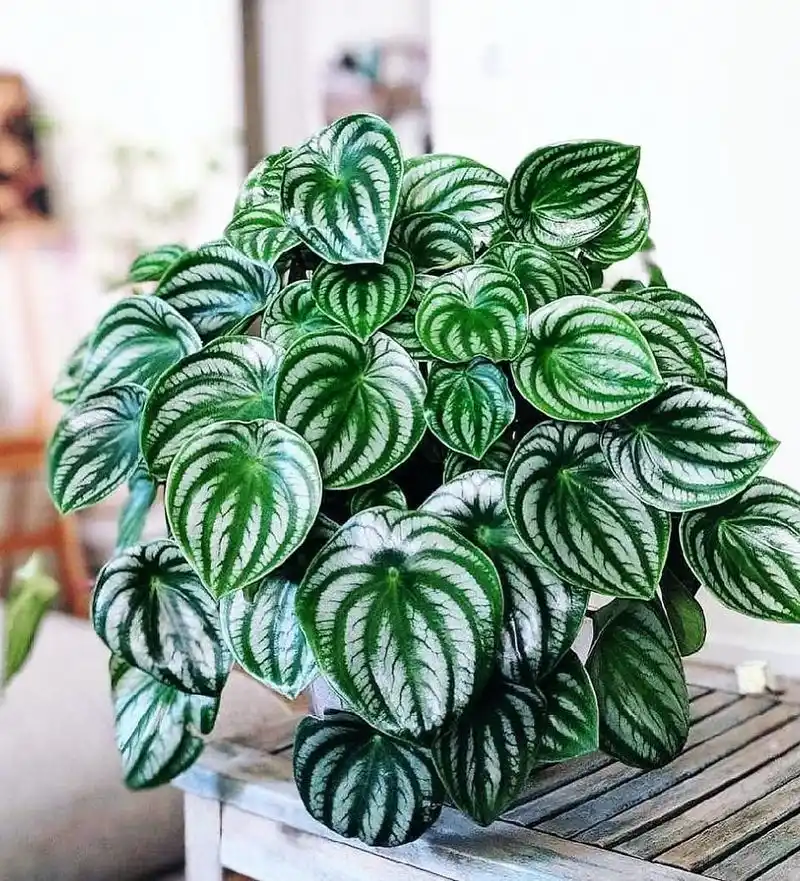
Peperomia, with its thick, textured leaves, is a testament to the beauty of simplicity. Its foliage varies from green to red, adapting its shades based on the light it receives. This plant is a resilient companion, thriving in both bright and moderate light, ideal for offices or homes. Its compact size makes it perfect for small spaces, offering a touch of greenery without overwhelming. Beyond aesthetics, Peperomia is pet-friendly, allowing plant lovers with pets to enjoy its beauty without worry. In tropical regions, it’s often found growing in the nooks of trees.
Stromanthe Triostar
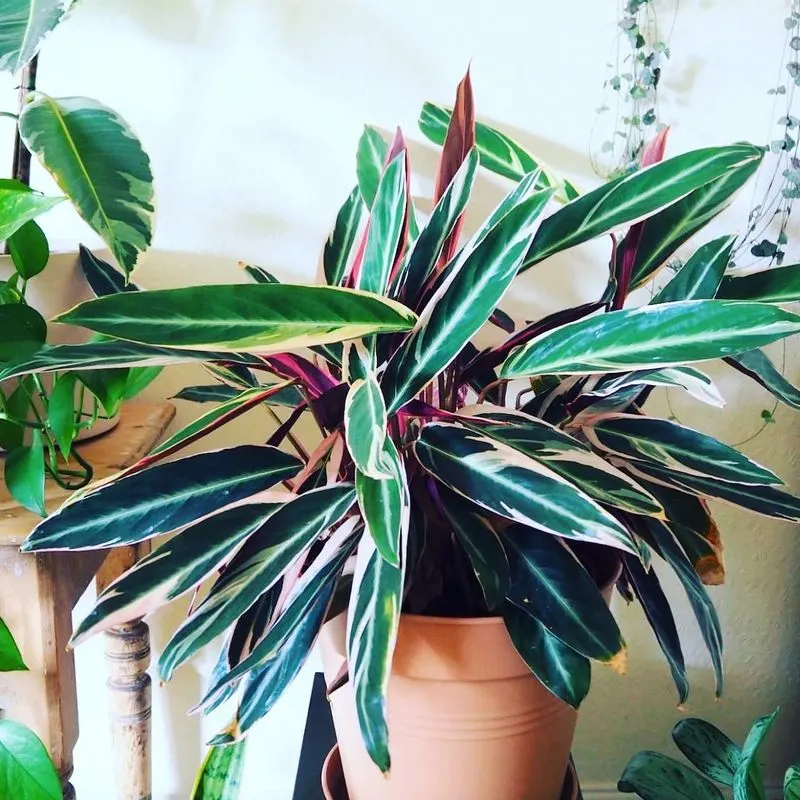
Stromanthe Triostar is a plant that wears its colors like a crown, flaunting variegated green leaves with pink undersides. Its beauty is amplified in diffused light, which brings out its vibrant hues. This plant is a bit of a diva, appreciating attention to its humidity needs to maintain its colorful display. A fixture in artistically decorated homes, it adds a splash of color and elegance. Originating from the rainforests of South America, it embodies the vibrant spirit of the tropics. For those seeking a living piece of art, look no further.
Zebra Plant
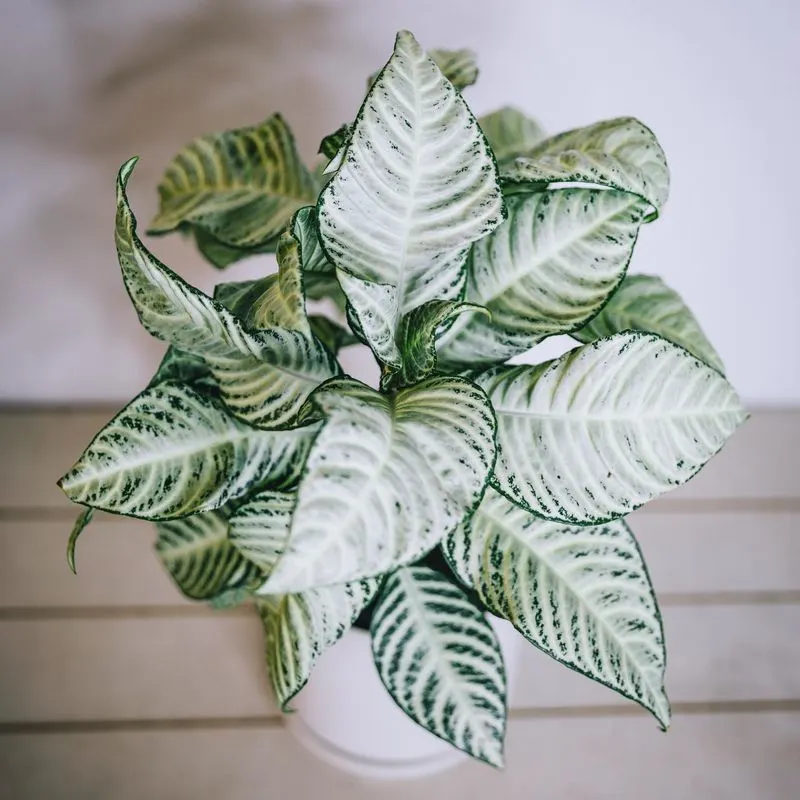
With its bold striped leaves, the Zebra Plant stands out like a fashionable accessory in any room. The dark green leaves are accented by bright white veins, and in optimal lighting, these stripes become even more pronounced. This plant craves humidity and indirect light, making it a striking addition to bathrooms or kitchens. Beyond its visual appeal, the Zebra Plant is known for its flowering ability, producing yellow blooms when well-cared for. Native to Brazil, it brings a touch of the exotic to indoor spaces, sparking curiosity and admiration.
Begonia Rex
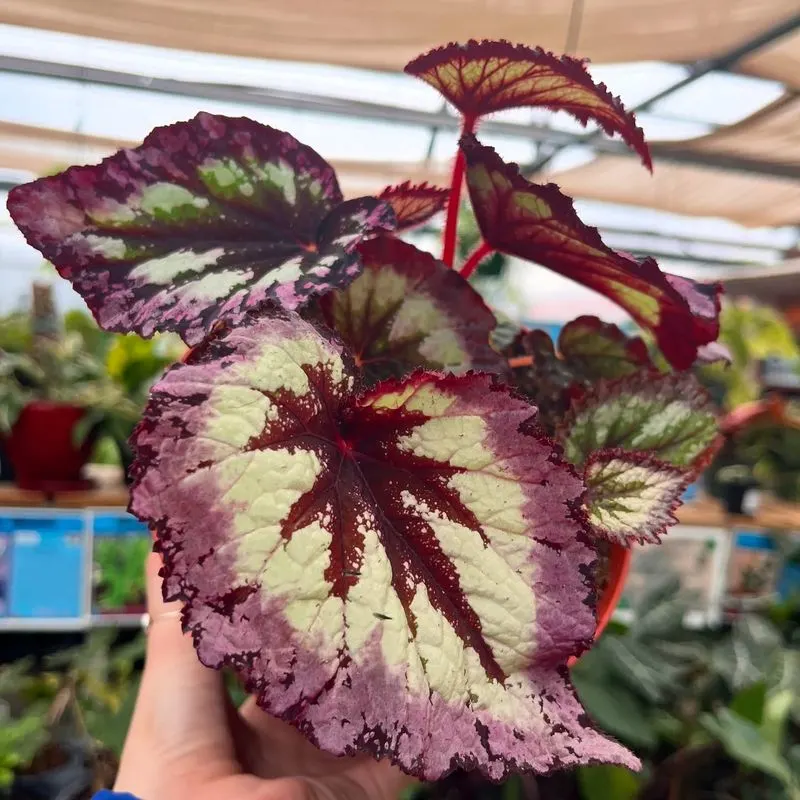
Begonia Rex is the rock star of the plant world, known for its spectacular leaf patterns. Each leaf is a masterpiece of colors, from deep purples and reds to silver and green. Light plays a significant role in its appearance, with brighter light enhancing its intricate designs. This plant prefers a bit of attention, rewarding patient caregivers with its showy foliage. Besides being a feast for the eyes, Begonia Rex is also easy to propagate, making it a generous addition to any plant collection. A quick fact: begonias have been cultivated since the 18th century!
Ficus Elastica ‘Ruby’
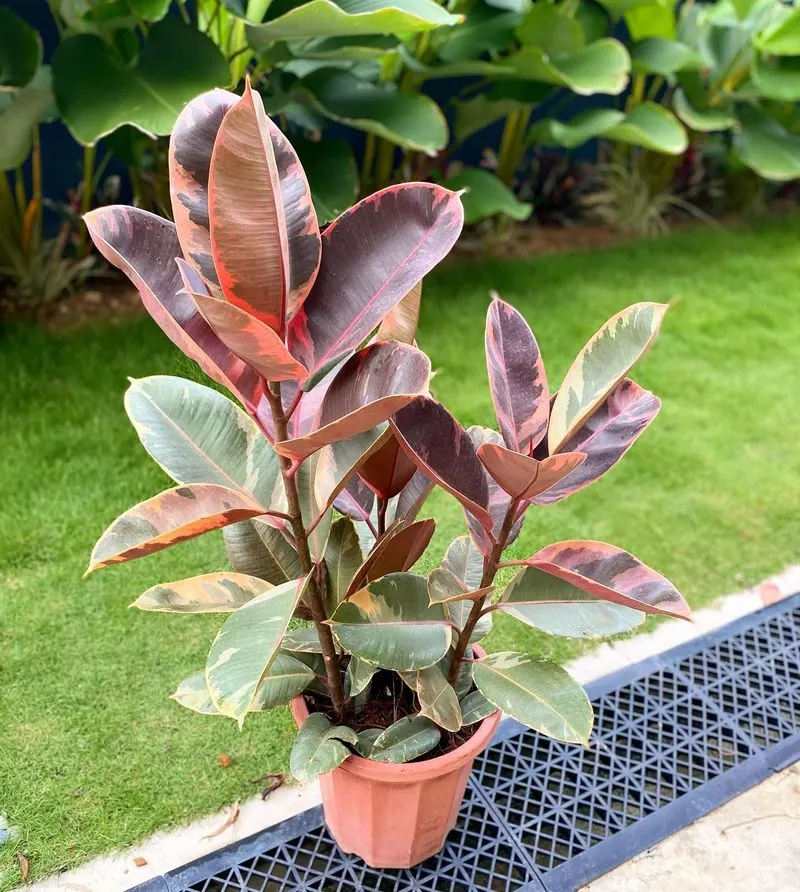
Ficus Elastica ‘Ruby’ is a statement piece, with glossy leaves that transition from deep green to vibrant reds and pinks. Light plays a crucial role in its color transformation, with brighter conditions bringing out its ruby hues. This plant is more than just eye candy; it’s also known for its air-purifying properties, making it a practical choice for health-conscious decorators. Easy to care for, it’s a favorite among indoor plant enthusiasts. Originally from India, it’s been embraced worldwide for its bold and beautiful presentation.
Tradescantia

Tradescantia, sometimes called ‘Wandering Jew,’ is a delightful mix of purple and green, with leaves that stripe like a candy cane. Its colors become more pronounced with filtered sunlight, making it a dynamic addition to any plant display. Known for its easy-going nature, it’s a favorite for both novice and experienced plant parents. Beyond its beauty, Tradescantia is also known for its fast growth, easily filling spaces with its trailing vines. A fun tidbit: it’s often used in hanging baskets, where its cascading habit can be best appreciated.
Ctenanthe Burle-Marxii
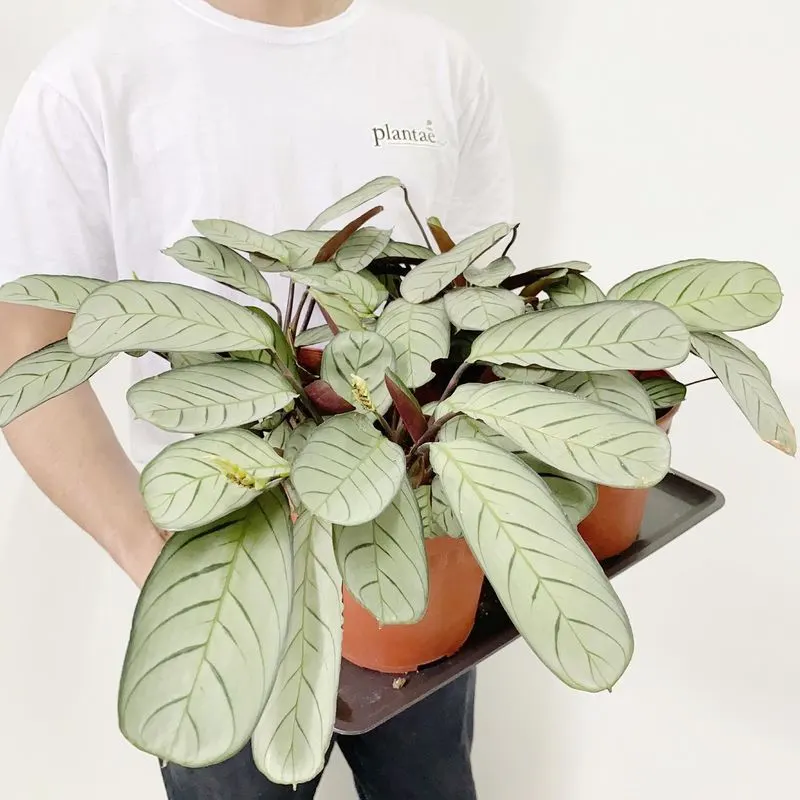
Ctenanthe Burle-Marxii, with its intricate fishbone pattern, is a plant that commands attention. Its leaves dance between shades of green and silver, creating a visual spectacle under moderate light conditions. This plant is a bit of an introvert, preferring shaded corners where it can showcase its beauty without direct sun. Known for its resilience, it thrives on consistency, rewarding caregivers with its steady growth. Native to Brazil, it’s named after the famous landscape architect Roberto Burle Marx, reflecting its architectural elegance.
Hypoestes Phyllostachya

Hypoestes Phyllostachya, more commonly known as the Polka Dot Plant, offers a playful splash of color with its spotted foliage. The pink, white, or red spots on its leaves become more vibrant with increased light, creating a lively display. This plant is an extrovert in the plant world, thriving in environments where it can be the center of attention. Perfect for desktops or windowsills, it adds a cheerful touch to any space. Did you know? The Polka Dot Plant is native to Madagascar, where it grows under the canopy in dappled light.

